Quality of the Environment in Japan 1993
(1) Rio de Janeiro Declaration on Environment and Development
The Rio de Janeiro Declaration presents action principles for the building of a global partnership and the realization of sustainable development, consolidating the conclusions drawn from debate between developed and developing countries on environment and development. When it comes to arguments on responsibilities for the global environ- ment, which constituted a focal point of debate between the developed and the developing worlds, it is stated that both developed and develop- ing countries have common responsibilities for conservation of the global environment. To quote the words in Principle 7 that "in view of the different contributions to global environment degradation, States have common and differentiated responsibilities," and that in light of the degrees to which loads had been inflicted on the global environment and other factors, there were differences between developed and devel- oping countries in the extents to which they had to hold themselves responsible. The notion that the present global environment has been deteriorated primarily by developed countries' economic activities, but that developing countries are also responsible for the realization of sustainable development and conservation of the global environment as members of the finite Earth, was articulated.
In line with the Declaration on the Human Environment at the Stockholm Conference in 1972, the Rio de Janeiro Declaration came out in the form of an expansion of the Stockholm Declaration with 27 principles in all. In response to debate on the right to development, it was declared in Principle 1 that mankind is entitled to live a healthy and productive life in harmony with nature; in Principle 2, that each country has the sovereign right to develop its own resources but is responsible for seeing to it that its activities do not inflict damage on the environ- ment of other countries; in Principle 3, that it is necessary to satisfy requirements for the next generation's environmental protection and development in exercising the right to development; in Principle 4, that it is necessary to work for the integrity of environmental protection and development; and in Principle 5, that it is necessary to cooperate in eliminating poverty for sustainable development. It is also declared that all sorts of entities, including women, young people and indigenous peoples must grapple with the realization of sustainable development, that peace, development and environmental protection are interdepen- dent and indivisible, and that cooperation must be rendered in carrying out the principles contained in the declaration with sincerity and the spirit of partnership.
(2) Agenda 21
Agenda 21 is a concrete action program for the 21st century for realization of the various principles contained in the Rio de Janeiro Declaration on environment and development. It consists of a preface and 40 chapters in four parts--(1) social and economic factors, (2) the conservation and management of resources, (3) the strengthening of the roles of main components of society and (4) means for implementation. It presents programs for tangible problems, such as measures to cope with atmospheric conservation, desertification, biodiversity, marine protection and wastes, and gives provisions for the ways in which funds, technology transfers, international institutions and international law ought to be executed for implementation of those measures (Fig. 3-3-1).
Fig. 3-3-1 Structure of Agenda 21
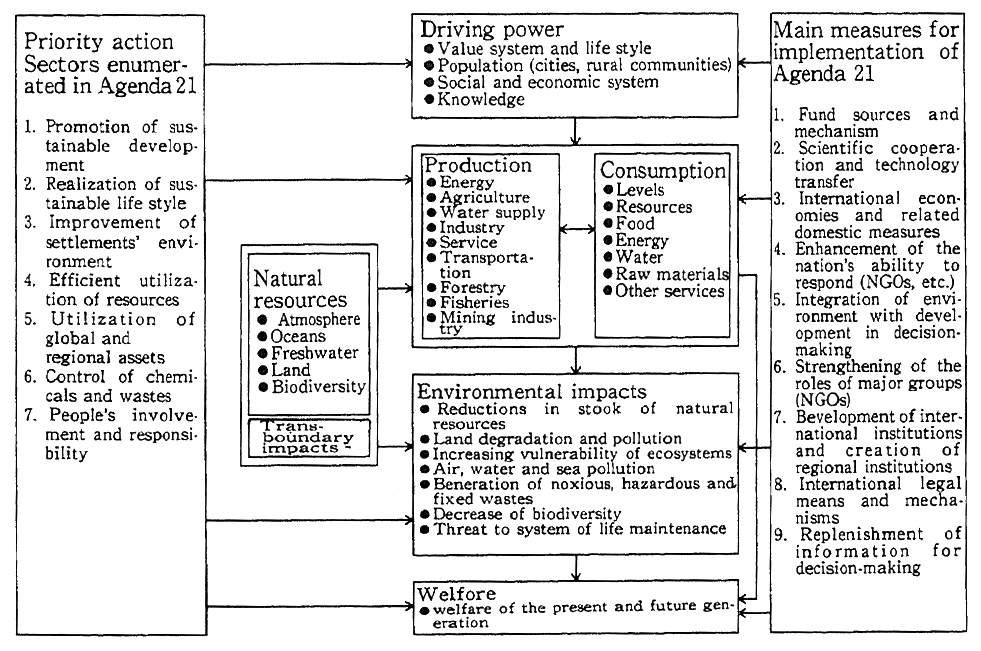
Source:Environment Agency
As regards the issue of financing, which was a main point at issue in the preparatory phase of the Earth Summit, Agenda 21 states that in regard to funding systems, global-environment facilities (GEF) should be reinforced and expanded in line with the Tokyo Declaration made at the Eminent Persons Meeting on Financing the Global Environment and Development. Concerning official development assistance (ODA) from developed countries, it was declared that the U.N. targets already accepted by developed countries should be promptly reconfirmed, and that aid programs should be further stepped up. When it comes to technology transfers, it was agreed to transfer technology "on favorable terms, including on concessional and preferential terms" and broaden the access of developing countries to developed countries' technology. Besides, it was agreed to work for the comprehensive promotion of measures, including economic measures in various sectors, in relation to the start of negotiations on a convention for the prevention of desertif- cation and warming. Moreover, the formation of nation-specific National Agenda 21 was called for and that of local governments' action program (Local Agenda 21) was encouraged, stating that it is necessary for all entities to take part in this venture. In addition, it was also agreed to establish a Committee on Sustainable Development under the U. N. Economic and Social Council for a follow-up of the achievements of the Earth Summit, to monitor the way in which Agenda 21 would be carried out and set up a senior advisory council for the Secretary- General of the United Nations.
(3) Conclusion of Climate Change Framework Convention and Biodiversity Convention
The Climate Change Framework Convention is designed to estab- lish a framework for grappling with the prevention of global warming with a view to stabilizing greenhouse gas concentrations in the atmo- sphere. Adopted on May 9, 1992, immediately before the Earth Summit, it was released for signatures by prospective member nations at the venue of the Earth Summit. In this convention, it is stated that policy and measures should be taken by developed and other countries, which are parties to the convention, recognizing that it will contribute to the purposes of the convention to stabilize the emissions of carbon dioxide and other greenhouse gases to the conventional levers by the end of the 1990s. It is also stated that information concerning the status of policies and progress reports should be shared by the signatory countries. With the signing done by Japan on June 13, the convention was also signed by 155 countries while the Earth Summit was in session.
The Biodiversity Convention is designed to conserve three levels of diversity including ecosystems, biological species and genes, the sustainable utilization of biological species and the distribution of benefits gained from gene resources in a fair and equitable manner. In the process of negotiations about this convention, there was a lively debate on funding mechanisms, the ownership of intellectual property and biotechnology, among others. Adopted on May 22, 1992, the conven- tion was released for signatures at the Earth Summit. The convention provides for a wide variety of measures for the conservation of biologi- cal resources and for funding mechanisms for developing countries. With the signing done by Japan on June 13, the convention was also signed by 157 countries while the Earth Summit was in session.
The Non-legally Binding Authoritative Statement for Global Consensus on the Management, Conservation and Sustainable Develop- ment of All Types of Forests is designed to present principles for contributing to the management, conservation and sustainable develop- ment of forests. Though agreement was not reached for its conversion into a convention, it turned out to be the world's first forest accord which expressed the importance of the conservation and sustainable management of forests. Actively taking part in the discussions of the preparatory phase, Japan significantly contributed to the setting of the course for the debate.
(4) Other Achievements (Approaches by NGOs, Etc.)
In terms of the numbers of participating countries and heads of state, the Earth Summit proved to be of the largest dimension in history. At the same time, many local governments and NGOs also participated in the summit, holding a broad variety of Earth Summit-related events. On June 4, Japan Day was observed with the participation of about 250 officials of 13 countries and eight international institutions to introduce Japan's experiences in, and approaches to, environmental issues while exchanging candid views on the role Japan should play in the future.
In the Brazilian city of Curitiba on May 28-29, the World's Cities Forum was held with the participation of 55 countries around the world and adopted the Curitiba Commitment to Sustainable Development. In the U. N. citation of local governments in Rio de Janeiro on June 3, 12 local governments around the world were commended for their leading approaches to conservation of the global environment. The Japanese city of Kita-Kyushu was honored for having taken the lead in interna- tional environmental cooperation.
Besides, the World Environmental Technology Fair where sound environmental technologies were displayed by 480 organizations and businesses from 21 countries, including 11 Japanese organizations and businesses, drew 150,000 visitors in the aggregate. Also held were the conference of NGOs, the 92 Global Forum with exhibits and other events and the World Conference of indigenous peoples where the Carioca Declaration and the World Charter of Indigenous Peoples were adopted.
3-3-3 Translating Earth Summit Achievements into Action
The global environment is deteriorating at a steady pace. As there is the need to reinforce measures as promptly as possible, each country must translate the contents of Agenda 21 adopted at the Earth Summit into action. Agenda 21 calls on each nation to prepare its own action program (National Agenda 21). At the Munich Summit held immediately after the Earth Summit, agreement was reached on the formulation and public release of national action programs by the end of 1993. Agenda 21 calls for making clear the measures which are to be taken by the 21st century from a perspective of sustainable develop- ment. Given the agreement made at the Munich Summit, Japan is stepping up work for the prompt preparation of an action program which may serve as a model for other countries of the world.
When it comes to other countries, Great Britain, for example, is carrying out a survey for the formulation of a national action program. The United States is also making a situation analysis and carrying out a survey on concrete measures. All those developments suggest that in response to Agenda 21, systems are being developed in each country.
Moreover, Agenda 21 calls for the establishment of a committee on sustainable development under the U. N. Economic and Social Council, surveillance on the implementation of Agenda 21 and coordina- tion in the United Nations, among others, for the framework of an international follow-up on the Earth Summit. It also calls for a recom- mendation to the Secretary General of the United Nations for the establishment of a senior advisory council (a council of eminent persons) under him or her.
In response to those calls, discussions were conducted on the streamlining of organizations for a follow-up on the Earth Summit at the 47th U. N. General Assembly held from November to December in 1992. As a result, the Committee on Sustainable Development (CSD) was established in February 1993. Japan was chosen as a member of the Asian group. The role of the Committee on Sustainable Development is to watch the implementation of Agenda 21 and the evolution of U. N. activities for the integration of environment with development, to follow up on the activities each country has begun for the implementa- tion of Agenda 21, to review the honoring of commitments made on technology transfers and financing incorporated in Agenda 21 and promote the Rio de Janeiro Declaration and the Non-legally Binding Authoritative Statement for Global Consensus on the Management, Conservation and Sustainable Development of All Types of Forest. The first meeting of this committee is scheduled to be held in New York in June 1993, and plans call for the holding of a meeting once a year in 1994 and subsequent years. Besides, it is agreed to establish a senior advisory council, which will be made up of eminent persons from around the world in a broad range of sectors to be dealt with by the Committee on Sustainable Development and provide counsel to U. N. Secretary General and through U. N. General Secretary to the Committee on Sustainable Development, the Economic and Social Council and the U. N. General Assembly (Table 3-3-3).
Table 3-3-3 Main Environment-Related International Conferences Held in FY 1992
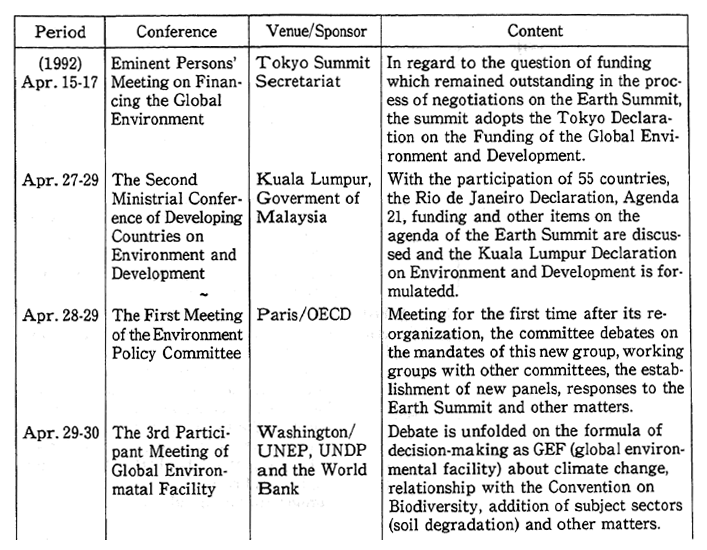
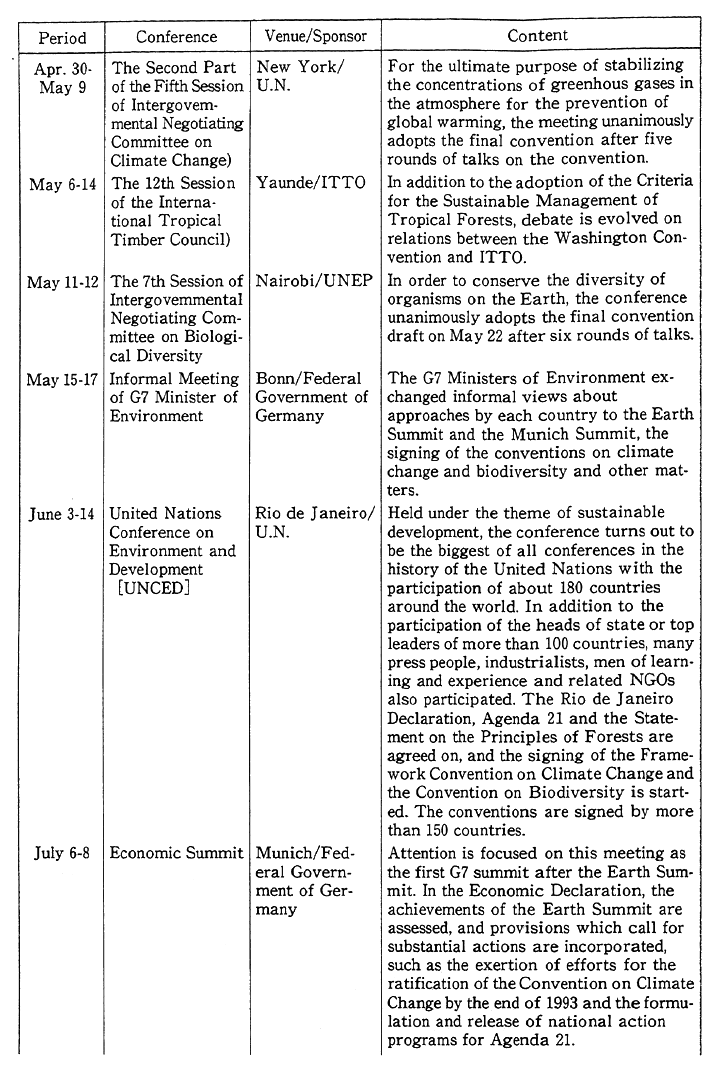
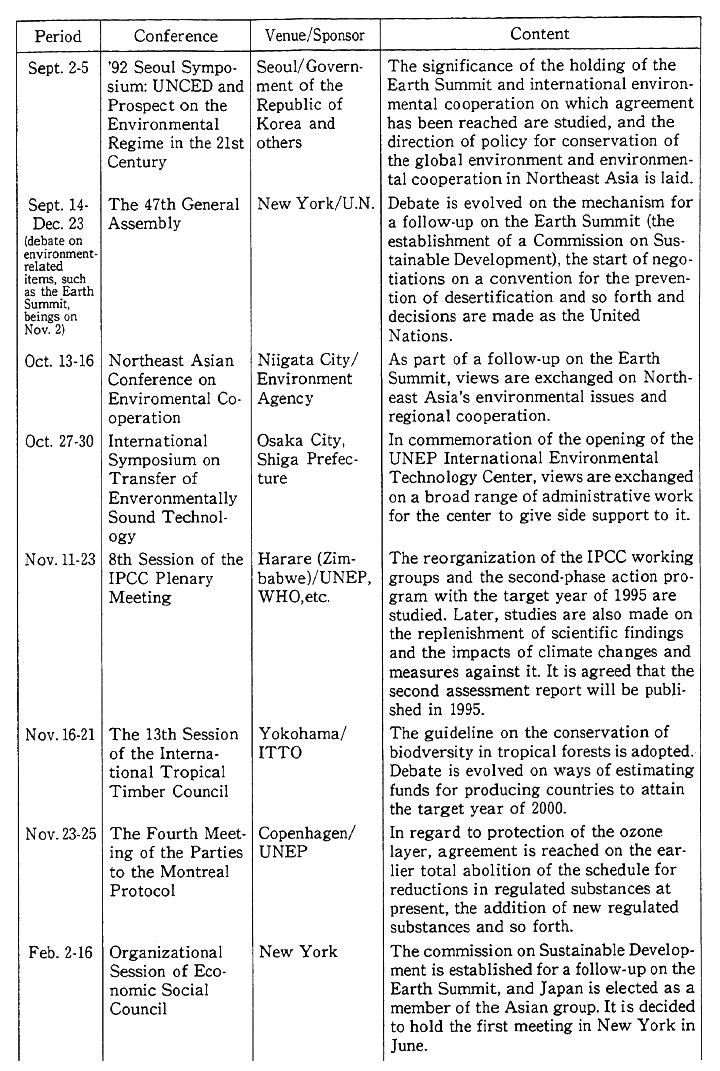
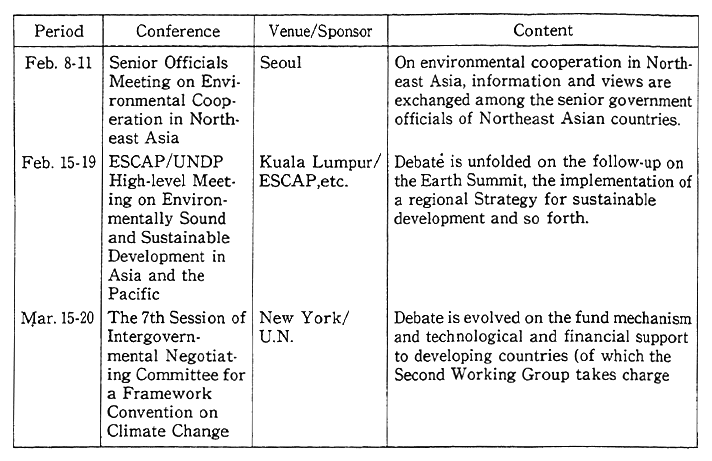
Source : Surveyed by the Environment Fgency
3-3-4 Review of Each Country's Institutional Approaches
Each country of the world must steadily carry out the achieve- ments of the Earth Summit to realize sustainable development. Given the world consensus worked out at the Earth Summit, developed coun- tries are reinforcing efforts to change their economic and social struc- ture from an unsustainable society, with a massive consumption of resources and a massive discard of wastes, to a sustainable society with less loads on the environment. On the other hand, developing countries have begun efforts for sustainable development of the sort in which environmental conservation is integrated with development.
(1) Review of Japan's Basic Legislation
a. Recommendations by Central Council for Environmental Pollutant Control and Nature Conservation Council
Japan has stepped up measures with the Basic Law for Environ- ment Pollution Control (enacted in 1967) and the Law for Conservation of the Natural Environment (enacted in 1972). Nonetheless, environmen- tal problems have broadened in scope in terms of their geographic impact as well as their impact on future generations. Against this backdrop, the Environment Agency made an inquiry to the Central Council for Environmental Pollution Control and the Nature Conserva- tion Council in July 1992 "on the way basic environmental legislation ought to be." The inquiry was referred to the Planning Panel of the Central Council on Environmental Pollution Control and the Natural Environment Panel of the Nature Conservation Council in July 1992, and those panels began to make studies on basic environmental legislation. After in-depth discussions, the councils filed a recommendation with the Director-General of the Environment Agency on October 20.
Beside the fact that environmental policy today has become broader than that for which the Basic Law for Environmental Pollution Control and the Nature Conservation Law were enacted, it is pointed out in the recommendation that it has become necessary to take up the environment itself in a comprehensive perspective; that considering policy methods, the conventional regulatory measures are insufficient and there is the need to review with the use of diverse methods, the way the economic society's systems ought to be; that it is necessary to positively contribute to, and cooperate in, the building of an interna- tional framework for conservation of the global environment, and that the framework (the two pillars of which are the Basic Law for Environ- mental Pollution Control and the Nature Conservation Law) is inade- quate to properly cope with the problems which have to be grappled with today, stressing the necessity of developing a new set of basic legislation responsive to new conditions which prevail today. For this, the recommendation says that a basic law which would incorporate basic ideals for environmental policy and a comprehensive frame,work for basic policy measures should be enacted, giving recommendations on 11 items associated with basic policy measures and the obligations of the central and local governments, entrepreneurs and people.
b. Bill of Basic Environmental Law
In response to this recommendation, the government stepped up in-house coordination and legal studies and came out with the general outline of a bill on March 8, 1993, and the Prime Minister inquired to the Central Council for Environmental Pollution Control and the Nature Conservation Council. The Cabinet approved it on March 12 for presen- tation to the Diet.
In the Bill of the Basic Environmental Law, three basic ideals are taken up. They are the enjoyment and succession of environmental blessings, the building of a sustainable society and the promotion of conservation of the global environment through international coordina- tion. Finally, the obligations of the central government, the local govern- ments, the entrepreneurs and the people for environmental conservation are made clear.
Second, in regard to environmental conservation measures, the bill, first of all, makes clear the formulation of measures and the guideline associated with the measures, drawing a basic environmental program and presenting the outline of the measures to the people. It provides for basic measures, such as environmental considerations in environmental quality standards, environmental pollution prevention programs and promotion of environmental impact assessments, regulatory measures for the prevention of impediments to environmen- tal conservation, measures for economic aid for environmental conser- vation, promotion of environmental conservation facilities and other projects, encouragement of the use of products contributory to cuts in environmental loads, environmental education, promotion voluntary activities in the private sector, promotion of science and technology, international cooperation in the conservation of the global environment and cost-sharing and financial measures, among others.
Third, the bill provides for the establishment of environmental councils in the central and local governments and so on.
Of them, the basic ideals are given below. In the ideals, the achievements of the Earth Summit and the accomplishments of the efforts Japan has made for environmental conservation for many years are given life and consolidated. The first ideal is: "In view of the facts that the maintenance of a sound environment with abundant blessings is indispensable for man's healthy and rich life and that as long as eco- systems have come into being by keeping a delicate balance and form the basis for mankind's existence, there is a danger that the environ- ment might be impaired by environmental loads from human activities, environmental conservation must be appropriately done so that the present and future generations may enjoy a sound environment with affluent blessings and that the environment which forms the basis of mankind's survival may be retained at present and in the future." The second ideal is: "Environmental conservation must be done by making it a principle that by reducing as far as possible environmental loads from socioeconomic and other activities and by assuring that other acts for environmental conservation may be voluntarily and positively done with the roles fairly shared by all persons, and that society may be lastingly developed while maintaining a sound environment with affluent bless- ings and working for the development of a sound economy with less loads on the environment" The third ideal is: "In view of the facts that conservation of the global environment is a task which is commonly assigned to mankind and comes in efforts for the assurance of a healthy and cultural life to the people at present and in the future, conservation of the global environment must be positively promoted with life given to Japan's capabilities in a system of international coordination.
(2) Each Country's Review of Institutional Frameworks
Besides Japan, other countries are working for the development and expansion of legal and other institutional frameworks.
In the United States, the Senate approved ratification of the Climate Change Framework Convention in October 1992. Taking the presidential oath in January 1993, President Bill Clinton, of the Demo- cratic Party, decided to establish an Office of Environmental (affairs) in the White House, working for Congressional approval for making the Environmental Protection Agency the status of Department. Besides, a high-level working group has been established to begin studies on forest and other issues in which there has been a divergence of opinion about development and protection. Australia arranged in December 1992 national strategies for sustainable development, which had been under study for some time. In December 1992, the European Community (EC) approved the Fifth Environmental Program (Toward Sustainable Devel- opment) for the building of a sustainable economic society and so forth. Germany is accelerating the pace of work for the compilation of environmental legislation, whereas the Netherlands is steadily stepping up work for the enactment of the Environmental Control Law as a basic environmental law with a broad range of sectors encompassed. In 1991, when preparations were being made for the Earth Summit, Denmark enacted an environmental law with sustainable development as an ideal for protection of the environment for not only man but fauna and flora as well. Denmark also formulated the Law on Grants-in-Aid for Envi- ronmental Conservation Activities in East European Countries to solve environmental issues there. In Asia, the Government of the Philippines established an in-house council on sustainable development in Septem- ber 1992 for a follow-up on the Earth Summit.
As we have just seen, administrative and legal frameworks are under review in each country. It might be said that the Earth Summit is significantly transforming society.
Chapter 4. New Role-sharing and Cooperation for coexistence with Environment
In line with the new concept and framework of environmental conservation we have seen in Chapter 3, we must take another look at social activities which affect the environment in such involute forms as we have observed in Chapter 2. For this, it is necessary for each entity of society to positively grapple with issues in an appropriate system of burden-sharing and cooperation. Nonetheless, the roles and cooperation may differ in substance, depending on each actual issue. In this chapter, let us examine different forms of cooperation and approaches.
4-1 Increasingly Important Burden-sharing and Cooperation
It might be described as a universal criterion both at home and abroad, going beyond the dimension of personal conviction, that man- kind should continue to modify various activities in coexistence with the environmentally finite Earth. In order that such criterion may be put to effective use, there exist many difficulties which have to be surmounted. In the following, an attempt will be made to introduce the difficulties observed in various areas, notify the general concept to improve these difficulties and concentrate on how to improve this situation.
4-1-1 Impediments to Solution of Problems
As we have seen in Chapter 2, consumer and various production activities are in a complex system of interdependence, from which a broad variety of environmental loads are generated. As we have obser- ved in Chapter 3, on the other hand, new ideals about, and responsibil- ities for, coexistence with the environment have been developed. In situations where concrete measures are to be taken in coping with various issues, however, we encounter a wide variety of difficulties, including the dearth of funds and technology. Of the conditions which tend to give rise to those difficulties, let us examine those which are commonly observed in the various environmental areas.
(1) Factors Making Recognition of Problems Difficult
Typical problems of environmental pollution in the past in which stack smoke, wastewater, noise and so on from specific generation sources, such as factories, would adversely affect the neighboring environment would in turn inflict damage on people. When it comes to those issues, the generation sources, impacts and the interactions of cause and effect were easy to grasp and residents had no difficulty in waking up to the impacts on their own lives so that it was easy to know how important a given problem was. When it comes to today's environ- mental issues, as represented by environmental pollution of the urban and household type and problems in the global environment, it is difficult to recognize the impacts and the complicated interactions of cause and effect. Besides, various frameworks, including family and company, take on an aspect of impeding an enhancement of conscious- ness which will tie in with concrete action. This may be well be de- scribed as a major factor which makes difficult the solution of environ- mental issues today.
The spatial spread of environmental issues makes it difficult to recognize and understand given problems. Inside the nation, too, it is difficult to recognize the sources of pollution which are geographically distant from the areas where impacts occur. When it comes to problems which crop up in foreign countries, such as those of developing coun- tries, interest is hard to arouse where effects have little relevance to everyday life. The present generation hardly responded to issues for which there is a time lag between cause and effect. As such grave issues will likely come out in the future, with global warming and the degrada- tion of biodiversity. Third, when it comes to the nature of impacts, people's attention may readily be aroused to directly perceivable prob- lems, such as instant impacts on health by hazardous materials and noise. But it is difficult to rally to issues which bring about chronic impacts and those which produce impacts over long spans of time, including the disruption of ecosystems.
Next, when it comes to causative factors and the interactions of cause and effect, the recognition of problems has become difficult. Up to now, there have been issues which are brought to light for the first time with an accumulation of scientific findings, such as the biological concentration of hazardous chemicals. Hypotheses on disruption of the ozone layer by chlorofluorocarbons (CFC) and so forth were not accepted in the beginning, but as the Antarctic ozone hole was discover- ed and scientific findings were increasingly accumulated, disruption of the ozone layer by CFCs became broadly accepted. As regards the degrees of global warming and its causative factors, there are calls for a further accumulation of scientific findings. As the areas where genera- tion takes place are far apart from those where impacts are produced, it is difficult in some aspects to probe the interactions of cause and effect for acid rain in which pollutants migrate. When it comes to the fact that the interactions of cause and effect are complicated, there is a danger, that causative activities will be continued without knowing that problems are brewing. When it comes to issues requiring further scien- tific debate, it may be difficult to mobilize people if they do not have sufficient interest.
Having said that, there are many problems, which are still insuffi- ciently understood. Unlike the conventional issues which centered on transient pollution, the issues posed today are those which are aroused by an accumulation of environmental loads, such as warming which affects climate of the entire Earth with an accumulation of carbon dioxide, the disruption of ecosystems under the impact of acid rain, and the depletion of tropical forests. These problems are difficult to correct even after identified. When it comes to such issues, whether people have a deeper understanding becomes a factor determining the ultimate success or failure of measures.
(2) Factors Making Implementation of Measures Difficult
Problems in which the causes lie not in specific and limited activities but in the whole of the socioeconomic activities are on the increase. As impacts on the environment are indirect and long-term, priority tends to be given to lealth, everyday conveniences and so forth in the community.
a. Changes in Mechanism for Generation of Environmental Loads
Once again, let us examine environmental problems of the con- ventional type. In situations where environmental pollution due to emissions from specific production activities, the whole issue could be solved simply by having the factories take measures for cuts in the emissions. But when it comes to the carbon dioxide and nitrogen oxide emissions and wastes many difficulties, arise, as they are generated in conjunction with broad everyday social and economic activities.
As we have seen in Chapter 2, our consumer and production activities indirectly bring about a wide variety of environmental loads through relations with industry. Insofar as environmental loads of this kind are concerned, it must be known that activities as a whole affect the environment, and that persons who are directly responsible for the emissions are not the only ones at fault. It has now become a task to effectively incorporate environmental considerations in diverse activ- ities while giving thought to various relations.
Next, when it comes to such emissions, the contributions of each emission source are extremely small both in terms of quantity and quality, but they take on a character of producing impacts as they are accumulated. Compared with individual generation sources of the con- ventional type, the impacts of which are big enough to inflict damage on man's health, it would be more difficult to introduce severe controls in the same manner. As regards regulatory measures, it would be difficult to go as far as to take up behavior of the sort which produces indirect impacts through relations with industry. In situations where so many emission sources are detected, regulatory measures would not give satisfactory results due to the difficulty of surveillance and other fac- tors.
Also when it comes to businesses and residents, it might be said that it is difficult to enhance motivation for the implementation of measures in situations where they can hardly detect the impacts of their own activities, which are indirect, where they think they produce merely the same extent of impacts as people around them, but not that they are producing unusual activities of their own.
Having said that, insofar as environmental loads as represented by carbon dioxide are concerned, it is difficult to assure results only with responses to unusual activities, and no solutions may be found with regulatory measures of the conventional kind.
a. Conflict with Other Benefits
As regards such problems as environmental pollution which directly affects man's health and large-scale natural disruption which goes as far as to produce grave impacts on the peripheral living environ- ment, the social priority of their solution is exceedingly high. But the environmental blessings include those which are invisible, those which take on a meaning only when they are viewed in a long-term perspective and those in which there is a time lag between persons who are to receive blessings and persons who are called to take measures. When it comes to those blessings, there are cases in which there arises conflict between them and other and regional benefits.
Such issues are involved in a comparison of the blessings of the present generation and those of the future generation in regard to global warming. Similar conflicts arise when one considers the burdens of those who are to receive benefits from the conservation of biodiversity and the burdens of developing countries which are to take measures, when it comes to environmental problems in a global dimension. Among internal problems, soil pollution in the farmlands at former factory sites drainage at abandoned mines and those the operation of which is suspended are the problems in which a post-pollution recovery is techni- cally difficult and there is a time lag between persons who receive benefits and those who suffer losses. When it comes to individuals' lives, for example, a question arises on how to take account of benefits from the use of private autos, electrical appliances and home delivery systems and the impacts their utilization directly and indirectly bring about on the environment. Then there is the question of pollution by nitrogen oxides and water pollution, caused by the concentration of industry. In regard to the protection of quality nature and wildlife, too, there is the problem that because the necessity, which is recognized in a nationwide perspective, is not considered important in areas where measures have to be taken and priority tends to be given to short-term production and livelihood benefits.
Questions spreading in terms of space and time like the question of the global environment and those which arise from diverse everyday economic and social activities are such that the question of a balance between benefactors, the difference between persons whose activities affect the environment and those who suffer the impacts, and the gap between persons who benefit from the protected environment and those who bear the cost of measures, are different from conventional issues, thereby making it difficult to come out with measures.
(3) The Difficulty of Rendering Cooperation Sought and Necessity of Social Responses
Having said that, it is indispensable that members of society, make united efforts to solve environmental issues in society of the sort in which the activities of each entity are inter-related.
In grappling with future environmental issues, it is expected that each entity of society will positively and voluntarily make their own activities amiable to the environment and engage in a wide variety of activities for environmental conservation. For this, it is necessary to overcome the difficulty of waking up to facts, mentioned in (1), above, and that of waking up to impacts referred to in (2)a, also above.
Next, In the contemporary society which sustains itself with an elaborate division of labor, there is the need to build an economic and social system in which organic responses, not just individual responses, by entities which are amiable to the environment. For this, it is required for each entity to play a role commensurate with its functions and build a vertical system of cooperation. When an attempt is to be made to streamline physical distribution for a reduction in the traffic volume, for example, there is the need for close cooperation between shippers and forwarding agents. For building a recycling system, it is necessary to establish a flow which extends from consumption to recovery, reproduc- tion and the use of reproduced items. For the maintenance of such cooperation, it is required to transcend individuals' perogatives to come out with some form of framework.
Nonetheless, the environment takes on the character of a free asset, on the one hand, so that it makes the maintenance of such cooperation difficult.
In the first place, the environment is something which cannot be exclusively occupied, so that the long-term environmental blessings which are common assets will be lost if individuals behave without taking account of impacts on other people and those on the environ- ment. As such, the "tragedy of commons" is cited as an example. In Great Britain long ago, there was a system in which commons were used as pastures. As all people competitively put cattle out to pasture, the story goes that grass was eaten away and the cattle could not be sustained. The same thing also holds true in the case of global warming and the excessive utilization of natural parks. In such eventualities, the protection of environmental blessings is important, but cannot be left entirely to individuals' judgment.
Second, environmental measures benefit not only persons who are taking measures, but those who are not doing so as well. There is a danger that this will lead to the appearance of free riders who will partake only of benefits without taking any measures. A case in point is the use of. private autos, enjoying the benefits of the atmosphere, while attempts are made to reduce nitrogen oxide emissions by avoiding their unnecessary use under strict self-discipline. While businesses compete with one another in their corporate activities, their profits will go down if they spend more money than other businesses. Here, there is a danger that they are less willing to take measures. The game theory is an attempt to analyze what actions a number of persons will take and what sorts of results on condition that their own gains are determined by each participants' action. Here, higher gains may be secured if the participants cooperate with one another less but secure gains if they don't cooperate. This phenomenon is known as a "social dilemma." Table 4-1-1 numerically illustrates the "social dilemma" for a moment that the world is made up by only two countries. In this table, have Nation A and Nation B decide which they are, "to take measures" or "not to take measures," and the gain of either nation will be deter- mined, depending on its and the other nation's option. If either nation does not take measures of its own, it will have to bear the cost; if both nations do not take measures, they will have to sustain the loss which is caused by a failure to do so. Here, if both Nation A and Nation B take measures, the gain of either nation will be 5; if either nation takes measures but the other does not do so, its gain will go down to 2. Therefore, if an attempt is made to maximize assured gains in a situation where the other country's cooperation cannot be expected, the gain of either nation will be 3.
Table 4-1-1 Examples of Social Dilemma
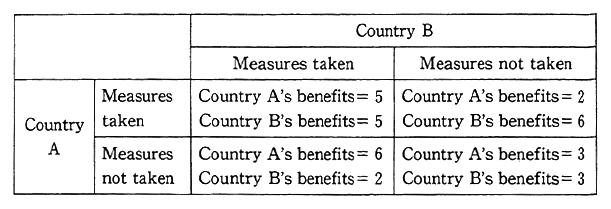
Source :Prepared on the basis of OECD's Negotiating a framework convention on climate change: economic considerations, 1992.
For overcoming the problems we have just seen and securing the cooperation of society as a whole, there is the need for changes in the consciousness of each individual and the socioeconomic system, and a wide variety of efforts are required with attention focused on the character of each issue.
What is required first are efforts to build a new conceptual framework about responsibilities for environmental protection, or a "code of environmental ethics," and to have it take root in society. For this, it is necessary to do research to cast light on environmental conditions and values and broadly disseminate the findings. Next, it is important to work for concerned efforts in the long run without relying on the consciousness of each individual, while attempts are made for the building of a social frame-work and the development of public facilities.
Of all issues the solution of which is called for at present, let us take up in 2, below, and its ensuing sub-sections some of those which come in different sectors and characters and check factors which make their solution difficult, the roles and cooperation each entity is called on to contribute and social conditions which make their solution possible.
4-1-2 Measures Against Air Pollution by Nitrogen Oxides in Major Cities
It has for long been the highest priority in environmental adminis- tration to do something about air pollution, which is immediately tied in with protection of the people's health. Nonetheless, air pollution by nitrogen oxides primarily in major cities has not been alleviated, and though various measures have been put into effect, further efforts are required. Here, let us see factors which make it difficult to alleviate pollution by nitrogen oxides and relations between necessary measures and each entity of society.
(1) Air Pollution by Nitrogen Oxides--Present State and Causes
As we have seen in Chapter 1, there has in recent years been no progress in the alleviation of air pollution by nitrogen oxides in Tokyo, Osaka and other major urban spheres, instead there are signs of an aggravation. In the areawide total pollutant load control areas for nitrogen oxides in the major urban spheres, which are fixed sources of generation, environmental quality standards are not satisfied in about half of the general-enivironment air monitoring stations and many of the automotive exhaust gas monitoring stations. And there are signs of a drop in the rate of monitoring stations where environmental quality standards are met. A check of the proliferation of polluted areas reveals, as is the case with the Bay of Osaka illustrated in Fig. 4-1-1, signs that the areas in excess of environmental quality standards are sprawling.
Fig. 4-1-1 Distribution of Environmental Concentrations of Nitrogen Oxide in Coastal Areas of Bay of Osaka
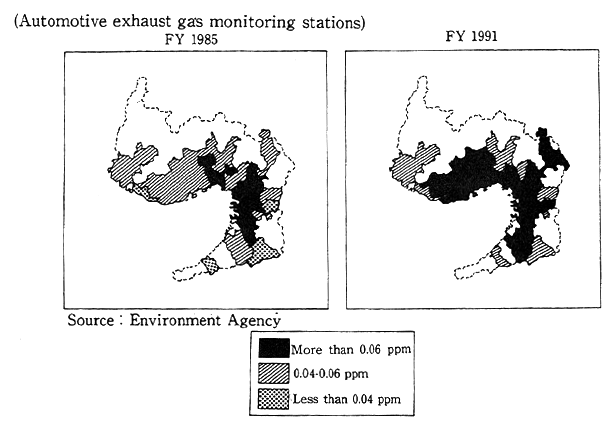
As nitrogen oxides are generated in conjunction with combustion, their generation sources are diverse. The generation sources may be classified into fixed generation sources, such as boilers, and mobile generation sources, such as autos. A check of the rates of contributions by those generation sources indicates that the rate of emissions from autos is high in major urban spheres. According to a survey of the Environment Agency, it is projected that when it comes to the genera- tion source-specific rate of loads by nitrogen oxide emissions in speci- fied areas in the automotive NOx method, the rate of emissions from autos is high, such as 53.3% in specified areas around Tokyo and 53.9% in specified areas around Osaka (Fig. 4-1-2).
Fig. 4-1-2 Emission Source-Specific Emissions in Specified Areas under Automotive NOx Law
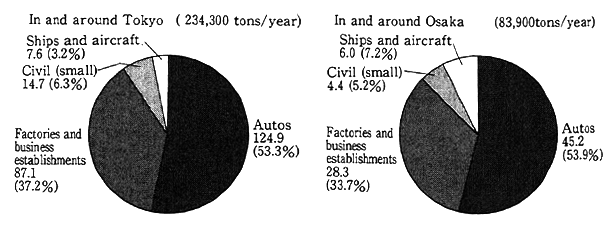
(1) Present State and Direction of Measures Against Nitrogen Oxides
When it comes to measures to cope with nitrogen oxide emis- sions, emission controls under the Air Pollution Law have been expand- ed five times since 1973 against fixed sources of generation. In 1982, a system of areawide total pollutant controls was introduced to Tokyo:s special wards and other areas, Yokohama City and other areas and Osaka City and other areas, and the volume of generation from fixed sources was reduced. As for autos, the so-called single-auto controls have been strengthened step by step since 1973. In accordance with the recommendation made in December 1989 by the Central Council for Environmental Pollution Control "Approach to Motor Vehicle Exhaust Emission Control Measures in Years Ahead." the reinforcement of controls is under way. A check of the strengthening of controls on nitrogen oxide emissions in terms of emissions at present in the cate- gory of gasoline and LPG-powered vehicle, reveals that the emissions were less than 1/10 for passenger cars and 1/5 for trucks and buses. In the category of diesel autos, they stand at 1/5-1/4 for passenger cars and about 2/5 for trucks and buses (with a gross body weight of 2.5 tons and over) of the direct injection type.
Air pollution has not been alleviated despite the strengthening of controls in this manner as there has been little progress in the reduction of automotive emissions as a whole. This is, as indicated in Fig. 4-1-3, because of increases in the traffic volume, primarily in major cities, and in the rate of diesel-powered vehicles have offset the effects of exhaust emission controls per vehicle.
Fig. 4-1-3 Volume of Concentrated Traffic in Tokyo Sphere (Use of Autos)
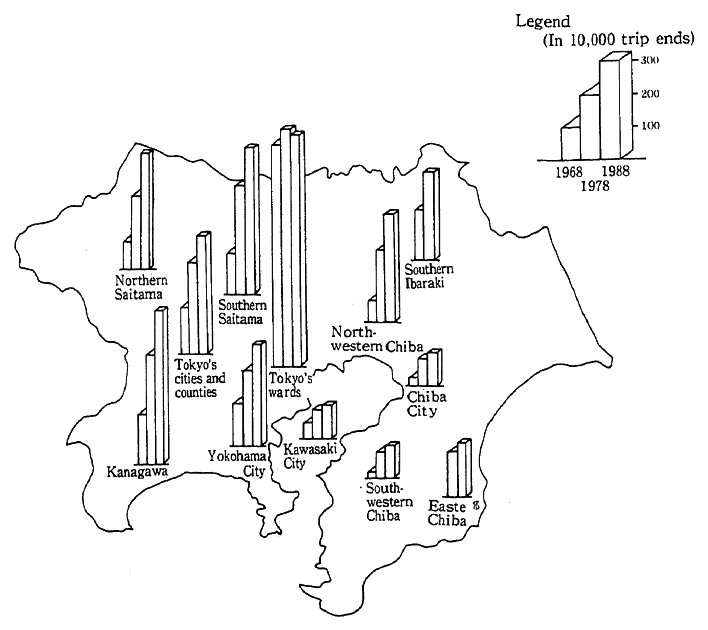
Source:TokyoMetropolitan City Sphere Transport Planning Council, Flow of People in Tokyo's City Spheres
The traffic volume of autos is on the upswing in the midst of the expansion of economic performances and their concentration in urban areas. Moreover, changes in the forwarding pattern, such as the utiliza- tion of home delivery systems and the spread of a just-in-time system (in which the stock is reduced and necessary things are delivered at neces- sary times). Technically, measures for diesel-powered vehicles are more difficult than those for gasoline-powered vehicles so that diesel-powered vehicles are left behind gasoline-powered vehicles in terms of emissions. On the other hand, the rate of diesel-powered vehicles primarily diesel trucks, has risen in recent years, because the fuel for diesel-powered vehicles is cheaper than gasoline and cost-effective. The diesel engines come in two types--direct injection and indirect injection--and the indirect injection type features less nitrogen oxide emissions. Of later, however, the output of the direct injection type which excels in durabil- ity and fuel consumption in terms of kilometers per liter has been on the rise. Yet another reason is that it takes time to shift to autos satisfying the latest series of controls as the years during which trucks and buses are used have become longer.
(3) Replenishment and Strengthening of Measures on Autos
In view of the above situation, it is now necessary to come out with comprehensive measures for reductions in the total emissions from autos.
In June 1992, the Law of Special Measures for Reductions in Total Emissions of Nitrogen Oxides from Autos in Specified Districts (Automobile NOx Law) was promulgated for further reductions in the emission of nitrogen oxides from autos. This law is to designate areas through administrative ordinance which are severely air-polluted by nitrogen oxide emissions from autos and to comprehensively enforce various measures in the areas. Standards for emissions from specified autos are formulated for trucks, buses and so forth which are used primarily in the specified areas. A system of controls by type of auto in which the control measures include a refusal to return automobile inspection certificates, among others, has been instituted for autos which do not satisfy the standards. To manufacturers, forwarding agents and other entrepreneurs, it is stipulated that the minister in charge of their business shall work out a guideline for the rational use of autos. The system of the law is illustrated in Fig. 4-1-4.
Figs. 4-1-4 Special Law of Measures for Reductions in Total Quantity in Specified Areas of Nitrogen Dioxide Emitted from Autos
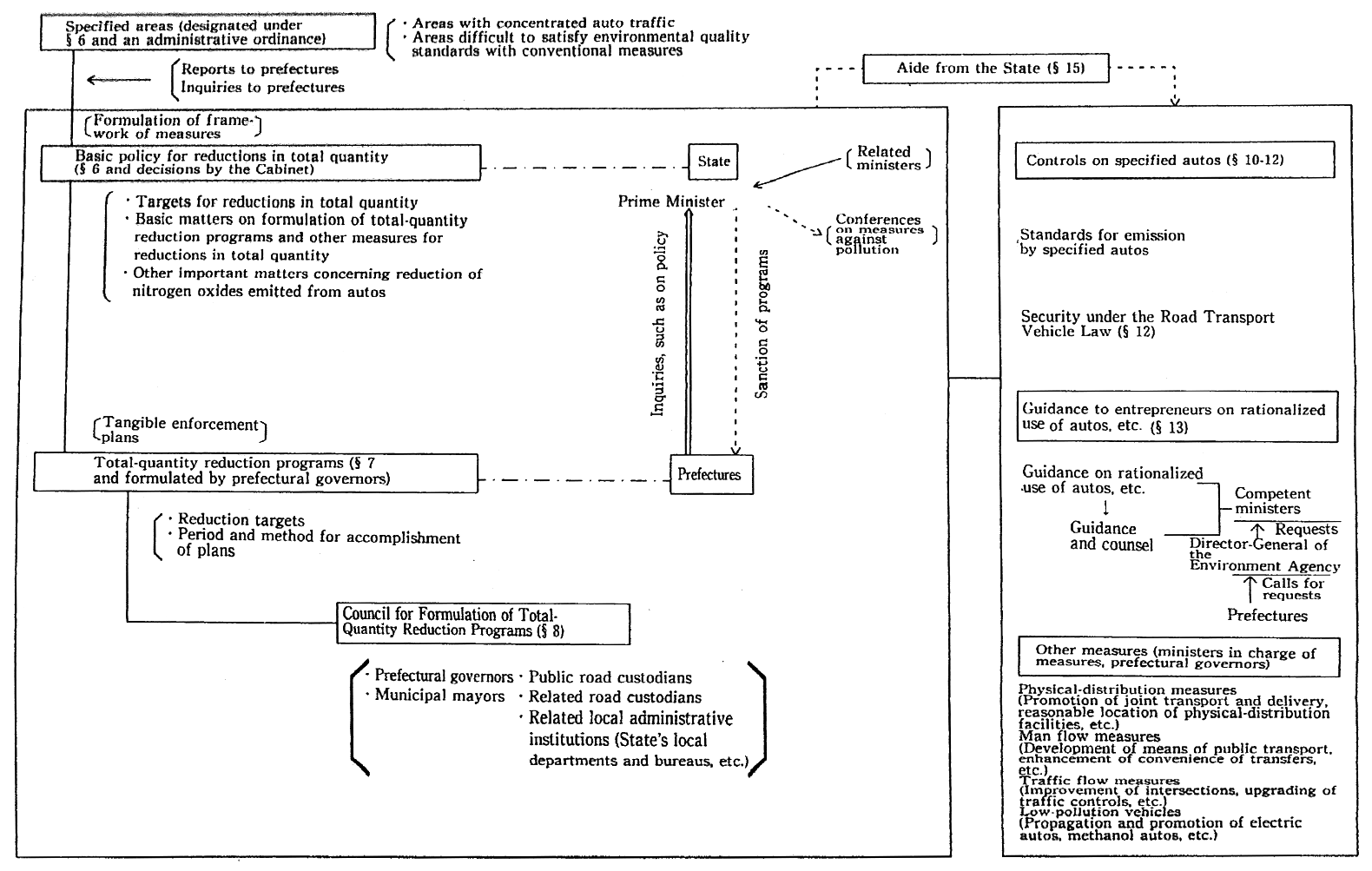
In accordance with this law, a basic policy for total-emission reductions (hereinafter refereed to as the "basic policy") is formulated as a basic item for measures which are to be implemented for cuts in the total emission of nitrogen oxides from autos in specified areas. The basic policy is a master plan for measures which are to be implemented in specified areas and has provisions for (1) the target of a reduction in the total emission of nitrogen oxides from autos, (2) basic matters on the formation of a program for a reduction in the total emission and on measures for a reduction in the total emission of nitrogen oxides from autos in specified areas, and (3) important matters on a reduction in the total emission of nitrogen oxides from autos in specified areas.
The measures which ought to be implemented are enumerated in the basic matters on measures in (2), above. First, the strengthening of measures on single autos, the aforementioned controls on types of autos, technologies for promoting the dissemination of electrical autos, meth- anol autos and other less-polluting autos and the development of fuel supply facilities are to be promoted. Next, measures on physical distri- bution, such as on the flows of persons are to be promoted, such as by improvements in the transport efficiency, reductions in the traffic volume of autos and the streamlining of physical distribution systems, and measures on the flows of people (such as by the streamlining of means of public transport and improvements in convenience) are to be stepped up. Moreover, it is decided to develop loops and bypasses for the dispersion of traffic and the divergence of multiple-level crossings for the easing of traffic snarls. Attempts are also to be made to work for the promotion of measures to cope with localized pollution around crossings where the concentration of carbon dioxides is high.
It is stipulated that the governors of prefectures in specified areas (Saitama Prefecture, Chiba Prefecture, Tokyo, Kanagawa Prefecture, Osaka Prefecture and Hyogo Prefecture) shall formulate a program for a reduction in the total emission, or a program for the implementation of tangible measures for a reduction in the total emission of nitrogen oxides from autos for specified areas in their jurisdiction.
It is thought that by carrying out those measures, the total emission of NOx from autos may be reduced by a little more than 30% from the present level (in 1990) in all specified areas according to a trial projection of the Environment Agency, as shown in Fig. 4-1-5, thus making it possible to generally achieve environmental quality stan- dards.
Fig. 4-1-5 Prospective Effects of Reductions in Total Quantity of Nitrogen Oxides Emitted from Autos in Entire Freas Specified under Automobile NOx Law
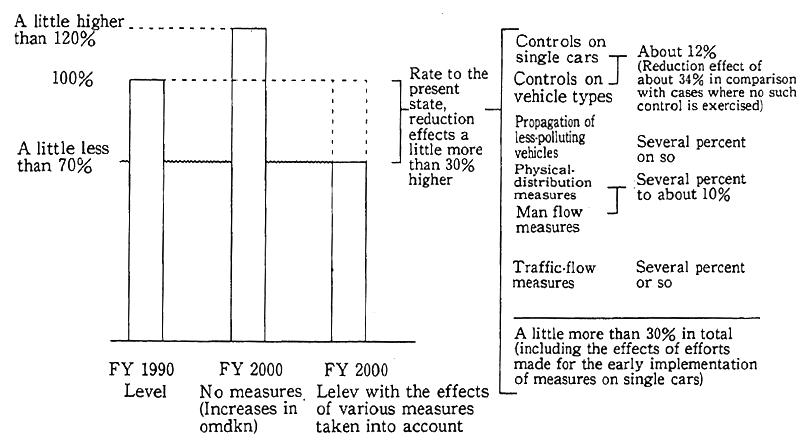
Source: Environment Agency
(4) Concerted Approaches Sought to Various Entities
In order to steadily promote the aforementioned measures and work for an alleviation of nitrogen oxide pollution, each entity is strongly urged to cooperate with one another in working for a reduction in the emission in view of the fact that the nitrogen oxides of autos are generated from the activities of various interdependent entities in society and the ways in which cities and physical distribution are today.
The State is asked to step up measures, such as those to promote the development of technologies and the development and dissemination of less-polluting autos by continuously making technical assessments for an early attainment of motor vehicle exhaust emissions reduction targets. It is also necessary for the central and local governments to actively deal with physical distribution, people-flow and traffic-flow measures which require the development of public facilities. It is also important to call on entrepreneurs and residents to cooperate in promot- ing the dissemination and enhancement of various measures.
Entrepreneurs are asked to work for a reduction in the emission of nitrogen oxides, depending on their business and transport.
First, motor vehicle manufolturers and so forth are called on to work for a cut in the exhaust emission per auto and to step up the development and dissemination of electrical vehicles methanol-powered vehicles and other less-polluting autos. For a reduction in the exhaust emission from a single auto, the cooperation of related entrepreneurs is required, besides the efforts made by motor vehicle manufacturers. It was pointed out that, when measures on gasoline-powered vehicles were to be introduced, tetraethyl lead, contained in gasoline in those days, would adversely affect the catalysts used for the purification of exhaust emission. But this problem has been solved as fuel makers strived to measures for lead-free gasoline. As regards reductions in nitrogen oxide emissions from diesel-powered vehicles, there are calls for cuts in the sulfur content of light oil, and efforts are being made.
Next, manufacturers and forwarding agents are urged to put business-license trucks to effective use, promote joint forwarding sys- tems, upgrade the transport efficiency (such as by having access to cargoes on the return trip,) and step up the utilization of appropriate means of transport, (such as the positive utilization of railway and maritime transport,) which centers on trunk-line transport between pivots of physical distribution in long and medium distances. For promo- tion of those measures, it is indispensable for shippers and forwarding agents to communicate and cooperate with one another. Tokyo and five prefectures and cities in the National Capital Region carried out measures on the volume of automobile traffic in the wintertime, in which entrepreneurs were asked to curb the use of autos by more than 10% on each Wednesday from November 1991 and January 1992, and made a questionnaire survey to come to understand the effects of those measures. Later, the business establishments which had been unable to cooperate in those measures were asked to report the reasons. Sixty percent of them said they could not do so by reason of production activities, and 51% cited "as requested by clients" as the reason (the replies are duplicated). The results suggest that there is the need for understanding and cooperation between entrepreneurs in addition to their positive efforts.
When it comes to community residents, the use of a single regular bus with a seatine capacity of 80 could substitute for as many as 80 private cars. if people could commute on a bus instead of their own cars, it is expected that they would voluntarily refrain from using them on unnecessary and non-urgent trips, such as by opting for public transport.
As regards stationary generation sources, there have been signs in recent years that the temperatures set for heating purposes have been on the upturn, and it is necessary to pay heed to the ways in which fuels and so forth are used. The Environment Agency and the related ministries and agencies are enforcing the Provisional Measures Against Seasonal Air Pollution in an attempt to make temperatures for heating reasonable in the wintertime.
In order to promote the aforementioned activities in the non- governmental sector, it is important to promote dissemination and enhancement activities for a deeper understanding about nitrogen oxides and closer cooperation in the enforcement of measures. As the prices of merchandise and services play a significant role as a determi- nant in economic activities, on the other hand, it is necessary to study relations between the economic aspects and the environment from a perspective of environmental conservation. For example, controls are introduced to encourage a shift to such types of autos that feature lower emissions.
Carbon dioxide is a substance which will affect man's health when its concentration is high, and there are calls for full measures for the maintenance of environmental quality standards. The individual emission sources which center on autos are small and it is generated as they appear one after another, so that there will be limits, both institu- tional and technological, to responses, should we try merely to cope with them merely with controls on individual generation sources. Moreover, the emission of nitrogen oxides is a question which arises in normal corporate activities and people's everyday life, such as the utilization of autos, and which is an issue that is associated with the urban structure and activities as a whole, so that the emission turns out to be a question difficult to solve. From a longer-term and wider-area perspective, there- fore, the only solution will be for entrepreneurs and residents to cooper- ate one another and grapple with emissions, depending on the degrees of impacts produced by the emissions and possible contributions.
4-1-3 Water Quality Conservation of Closed Waters
Bays, inland seas, lakes, reservoirs and other closed waters provide our lives with a broad variety of blessings. But, characteristi- cally, pollution tends to aggravate those waters, even though they are indispensable. Here, let us see causes to pollution in closed waters and relations between necessary measures and each entity.
(1) Blessings of Closed Waters
A check of the blessings of bays, inland seas, lakes, reservoirs and other closed waters indicates that they provide our lives with a wide variety of blessings as fishing grounds, recreation and other sites. The users of major bathing beaches along the Bay of Tokyo, the Bay of Ise and the Seto Inland Sea totaled 15.8 million in the aggregate (according to the water quality survey of major bathing places in fiscal 1992). The actual catches in 1990 which consisted of those in sea-surface fishery and culture came to about 80,000 tons, valued at about ¥26.9 billion for the Bay of Tokyo, about 150,000 tons, valued at about ¥48.7 billion, for the Bay of Ise and about 740,000 tons, valued at about ¥274.9 billion (some of them included hauls in other waters). Assigned with the impor- tant function of supplying freshwater, lakes and reservoirs are broadly utilized as sources of tap, irrigation and industrial water. Of the intake for tap water services, more than 30% comes from lakes and reservoirs (including dams). Besides, many of the closed waters involve valuable waters as natural environments, such as superior scenic spots, fly-in places for water birds and so forth and tidelands for the habitation of diverse organisms. The natural environment including tidelands and lake shores is evaluated in regard to functions for water purification. According to a survey on functions for water purification in reed fields into which household effluents flow, it is suggested that the contents of BOD, COD, nitrogen and phosphorus have significantly decreased (Table 4-1-2).
Table 4-1-2 Balance, Purification Volume and Removal Rate of Pollutants in Ditch Reed Fields (Hachigo Town, Ibaraki Prefecture)
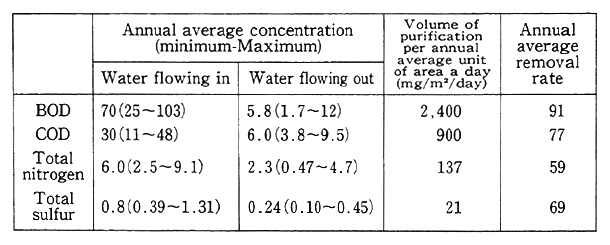
Source:National Institute for Envimonmental Studies
(2) Conditions of, and Causes to, Pollution of Closed Waters
On the other hand, we are using closed waters as the destination for wastewater. Natural waters are equipped to purify water and provide blessings within their capacity in terms of the purification of environmental loads from human activities. But as the inflow of pollut- ants become excessive, the purifying function is impaired, eventually leading to a loss of other values related to closed waters. Particularly in closed waters, the exchange of water is poor and materials tend to remain. Besides, they are vulnerable to pollution because there arises a phenomenon, known as eutrofication, in which the water quality pro- gressively deteriorates in conjunction with the propagation of duck- weeds and so forth. Given this factor, it is a fact that the environmental quality standards on organic pollution in closed waters is lower than in rivers and seas. When it comes to lakes and reservoirs, for example, the achievement rate of environmental quality standards in fiscal 1991 stood at 42.3% (COD), lower than the 75.4% (BOD) registered for rivers. The rate was 62% (COD) for the Bay of Tokyo and 59% for the Bay of Ise, lower than the 80.2% marked for all sea regions.
As regards closed waters wide in area, such as the Bay of Tokyo, and major lakes and reservoirs, population is concentrated on their hinterlands and brisk economic activities are conducted. The concentra- tion of such activities gives rise to pollution. The population of areas subject to controls along the Bay of Tokyo, the Bay of Ise and the Seto Inland Sea was about 65 million in 1989, and that of designated areas from which water flows into nine lakes and reservoirs designated under the Law of Special Measures for Conservation of the Water Quality of Lakes and Reservoirs (Lake and Reservoir Law) exceeds four million. The pollutants which are at issue nowadays are organic matter which may be computed in terms of COD, and nitrogen and phosphorus which gives rise to eutrofication. These substances are generated by various causative factors, such as household effluents, livestock industries, marine culture, farmlands and urban areas, to say the least of industrial wastewater. A check of the emission source-specific rate of loads on Kasumigaura and Teganuma, designated under the Lake and Reservoir Law, indicates that loads of the livelihood type have a significant share, as you will see in Fig. 4-1-6. Having broad areas for the intake of water, including other activities, Kasumigaura is tied in with diverse genera- tion sources, whereas Teganuma, located in an urbanized area, features an especially high rate of loads of the livelihood type.
Fig. 4-1-6 Rate of Loads in Lakes and Reservoirs by Generation Source
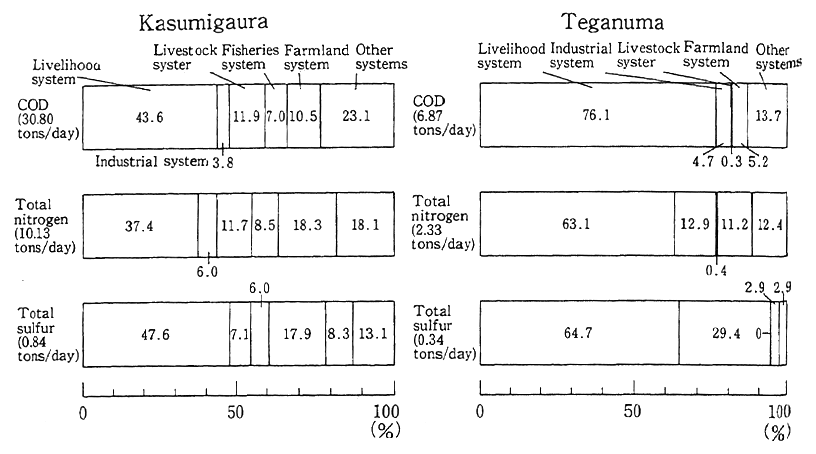
Note: "Other systems" includes discharges from forests and built-up urban areas, rainfall, etc.
Source: Environment Agency
(3) Water Quality Conservation Measures and Roles Asked of Various Entities
For conservation of the water quality of closed waters, it is necessary to take appropriate measures for all water intake areas where pollutants are generated and discharged. Here, there is the need to step up measures against each generation source which produces impacts. Various entities which undertake activities in areas for the intake of water are expected to make the following approaches.
Administrative authorities are asked to formulate a framework of measures, depending on their dimensions and capacities and on their association with entrepreneurs and residents, and to specify a direction in which various entities may appropriately promote diverse measures. For this, it is important to formulate and promote areawide total load reduction programs for sea regions and programs for conservation of the water quality of lakes and reservoirs by prefectures and programs for the promotion of measures against household effluents by municipal- ities. It is also required to develop facilities for the disposal of household effluents which satisfy regional characteristics for conservation of the water quality and promote public works projects, such as water conduc- tion and dredging work. Moreover, it is necessary to work for the legitimation, support and promotion of nongovernmental measures.
With the Water Pollution Control Law revised in 1990, a system was introduced under which prefectural governors would designate as "priority areas for measures against livelihood effluents" the areas particularly required to step up measures by municipalities under their jurisdiction. Table 4-1-3 provides an outline of the program formulated for the promotion of measures to cope with livelihood effluents, which Tsuchiura City implemented in a water intake area of Kasumigaura to improve the water quality of rivers in the city and Kasumigaura. Under this program, efforts are being made to develop various facilities and promote comprehensive measures, such as direct purification projects.
Table 4-1-3 Planned Targets of Program for Promotion of Measures to Cope with Livelihood Wastewater in Tsuchiura City
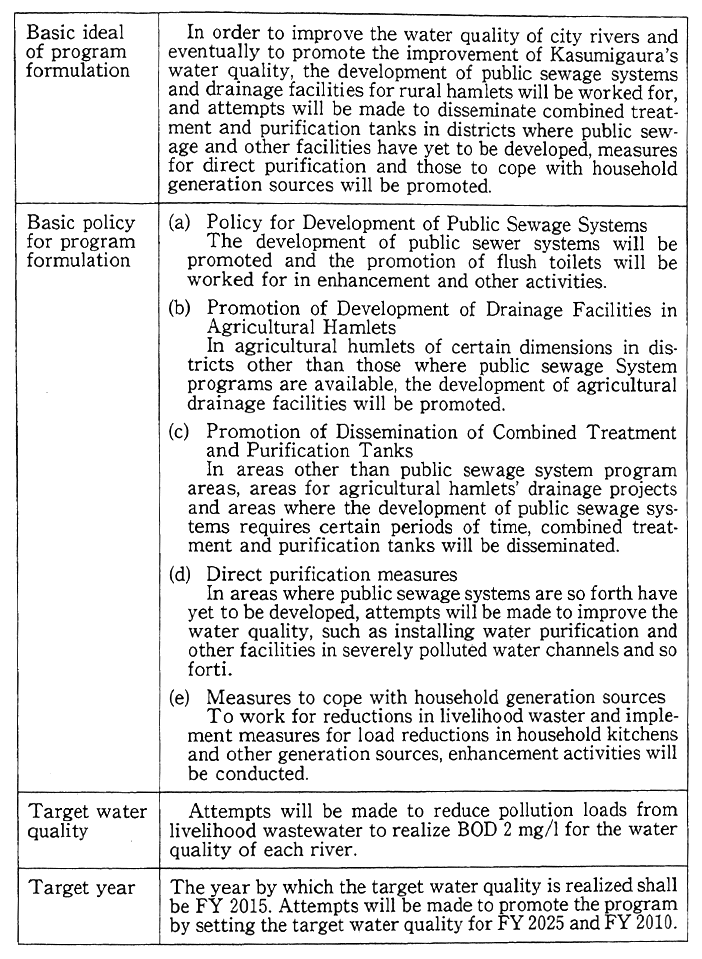
Source:Prepared by the Environment Agency on the basis of the Tsuchiura City Livelihood Measures Promotion Program (March 1992)
Entrepreneurs in water intake areas are expected to comply with various control standards and see to it that they will undertake activ- ities with less environmental loads. Factories and business establish- ments are asked to abide by drainage standards under the Water Pollution Control Law and the ordinances added by prefectures, and to comply with areawide total pollutant load control standards in the areas of sea regions and areas designated under the Lake and Reservoir Law.
Livestock industries are regulated with drainage controls, depen- ding on their scale, and in the areas designated by the lake and Reser- voir Law. As for farmland, it is expected to rationalize fertilizing methods and appropriately control the water of paddy fields, depending on the actual conditions of farm management. In regard to fish culture, regulations are imposed on management under the lake and Reservoir Law.
Residents in areas for the intake of water are asked to work for reductions in the loads of household effluents. When it comes to the propagation of facilities for the disposal of household effluents, it is necessary for individuals to bear the costs for construction work for the discharge into sewer systems of effluents from each household and for the installation of combined treatment and purification tanks, among others. Livelihood effluents may be reduced with attention paid to them in the everyday life, and each family is expected to make efforts. An opinion poll was taken in February 1993 on environmental conservation, in which 61.9% said that they tried "not to let frying oil and leftovers go into the kitchen sink," suggesting that they were highly interested in paying attention to conservation of the water quality. On the other hand, a check of the rate of carrying out mandatory water quality tests under the Purification Tank Law reveals that it came to an extremely low rate of 10.5% in fiscal 1991. Though efforts are made, it is required for each sector, including residents, to pay more attention to the appropri- ate treatment of effluents from each household.
In addition to these efforts, it is promote the realization that bays, lakes and reservoirs, among others, are common assets, and to encour- age administrative authorities, entrepreneurs and residents to cooperate in working for the cleaning of coasts and lake shores and water chan- nels to cut the inflow of polluted water from urban areas.
When it comes to closed waters, pollution is caused from a broad range of activities, the proliferation of which eventually poses problems- As the strain produced by each individual and the effect of measures taken by him are difficult to recognize, it becomes all the more impor- tant for people to have the opportunity to enjoy the blessing of the sea, lakes and reservoirs in order that a broad segment of people take interest in conservation of the water quality. An example of such efforts is that Ibaraki Prefecture is carrying out the Training for Communion with Kasumigaura in which communion with Kasumigaura and the consciousness about water purification are enhanced by using the Kasumigaura Communion Land and ships aboard which the water quality may be surveyed and organisms may be observed. In the Seto Inland Sea, seaside classes for training and lectures are held in related prefectures and administrative ordinance-designated cities under the Basic Program for the Environmental Conservation of the Seto Inland Sea.
4-1-4 Recycling for Drops in Environmental Loads
In conjunction with a rise in the utilization of a wide variety of materials, loads on the environment are on the upswing in Japan. Given this factor, the promotion of recycling has become important. Here, let us examine trends in the volume of materials used, first, and then the present state of recycling and the problems posed with paper as an example.
(1) Ever-Increasing Volume of Matter Used and Necessity of Recycling
In conjunction with its economic activities Japan massively gathers mineral and biological resources from nature, uses them and puts them back into it as wastewater, waste gas, trash and other unnecessaries. In order to come to grips with the utilization of matter in such a fashion, let us see the comprehensively computed of the flow of matter associated with Japan's economic activities. In fiscal 1990, about 2.1 billion tons of resources were gathered both at home and abroad, and a total of about 2,160 million tons of resources, including about 60 million tons of imported goods and so forth, were put into its economic activities. As a result, about 770 million tons of unnecessaries were discharged, about 70 million tons of goods were exported and the remaining 1,310 million tons were accumulated for the construction of buildings and durables. About 200 million tons were once again recycled (Fig. 4-1-7). The volume of matter used by Japan is on the upswing, and a check of secular trends in the volume of resources gathered and that of unnecessaries discharged reveals that the volume of resources gather- ed in fiscal 1990 was about 1.4 times more than 20 years before and that of unnecessaries discharged was also 1.7 times more (Fig. 4-1-8).
Fig. 4-1-7 Japan's Material Balance
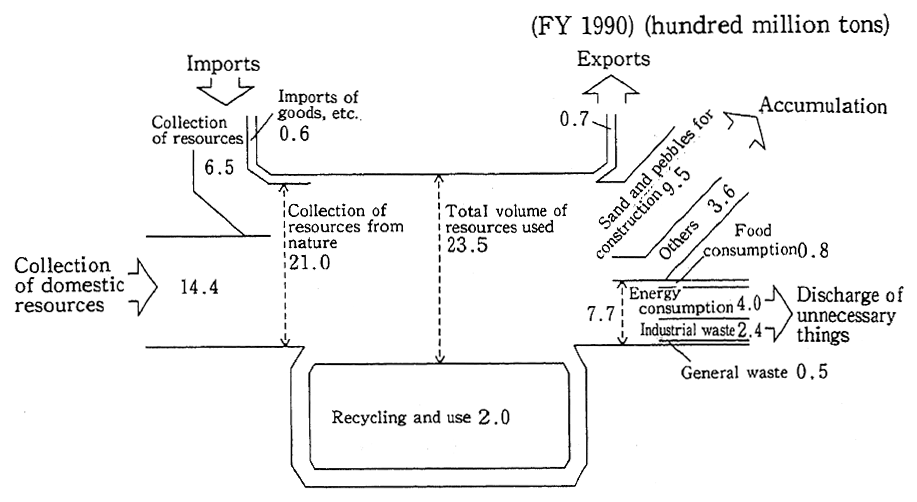
Note: In conjunction, with the renewal of various statistics, values are renewed from the Material Balance carried in the White Paper on Environment for FY 1992.
Source: Computed on a trial basis by the Environment Agency from various statistics
FIg. 4-1-8 Trends in Japan's Material Balance
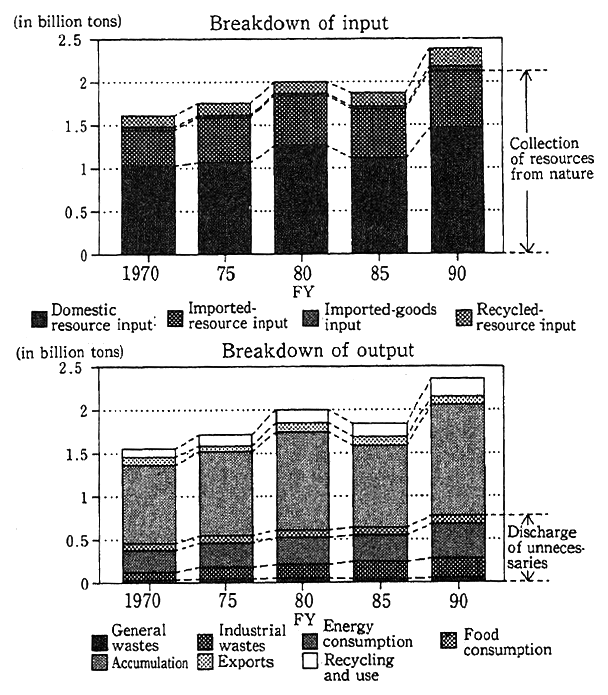
Source: Computed on a trial basis by the Environment Agency from various data
Nature's ecosystems have such a system of circulation which is represented by a pattern in which "microorganisms dissolve the corpses of animals, plants grow with the microorganisms as nutrients, and animals eat the plants." In situations where the volume of resources collected by man and discharged by him are fully compatible, both quantitatively and qualitatively, with the circulation of ecosystems, environmental pollution and the depletion of resources do not take place, as excreta are once again converted into resources by the circula- tion system. Since the Industrial Revolution, however, collection and discharge so much exceeded nature's circulating stability, both quantita- tively and qualitatively, that localized environmental issues began to crop up. Later, Man's economic activities were maintained and expand- ed in such a manner as to newly look on the natural environment as a source of material supply and a place where unnecessaries were to be dumped. Nonetheless, while the volumes of collection and discharge remarkably increased in conjunction with an expansion of the economic scale, the utilization came close to the limit of the Earth's carrying capacity, giving rise to problems in a global dimension, such as the depletion of resources, the extinction of species and the degradation of the environment. Thus, when environmental issues are taken into account by tracing back to its origins, it might be said that they have come out as the volume of resources collected and that of unnecessaries discharged have quantitatively and qualitatively surpassed nature's circulation capacity. As we have seen from the aforementioned balance of matter, the volumes of resources collected and unnecessaries dischar- ged in association with Japan's economic activities have continued to rise and, as a result, loads on the environment have also continued to increase. To make the Japanese economy impose less environmental loads in this situation, it is necessary to make the collection of resources and the discharge of unnecessaries qualitatively compatible with nature' s ecosystems. For this, there is the need to reduce the consumption of less useful commodities and unnecessary energy, promote the utilization of biological resources and nature's energy in a sustainable form and discharge unnecessaries into the natural environment in as a harmless and bio-degradable form.
For this, recycling is also an effective means. By recycling unnecessaries into resources, matter may be circulated in the system of human activities, so that it is possible to reduce the collection of resources from nature and the discharge of unnecessaries into it, while consumption is sustained.
In recycling, however, it would turn into mass-consumption and mass-recycling, should emphasis be put only on the collection of re- cyclable resources from discharged unnecessaries. The purpose of prompting recycling in terms of environmental conservation is to cut back the environmental loads brought about by society as a whole. It is necessary to promote efforts to take another look at packing methods, while striving not only to recycle unnecessaries but, in the phases of production and distribution, to produce and sell merchandise with unnecessary components minimized.
In stepping up the recycling of unnecessaries, the generation of wastes is curbed, energy in the production process is saved, and the input of natural resources is curbed. On the other hand, additional energy is required, thereby raising loads on the environment. It is necessary to further scientific findings on the effects of environmental conservation by recycling so that total environmental loads may be reasonably cut back by recycling.
Given such a premise, recycling is an effective means to reduce loads on the environment. Under way at present is the recycling of such consumer goods as paper, pins, cans and old cloth and various industrial wastes.
Fig. 4-1-9 Problems on Management of Collectors of Resources for Recycling
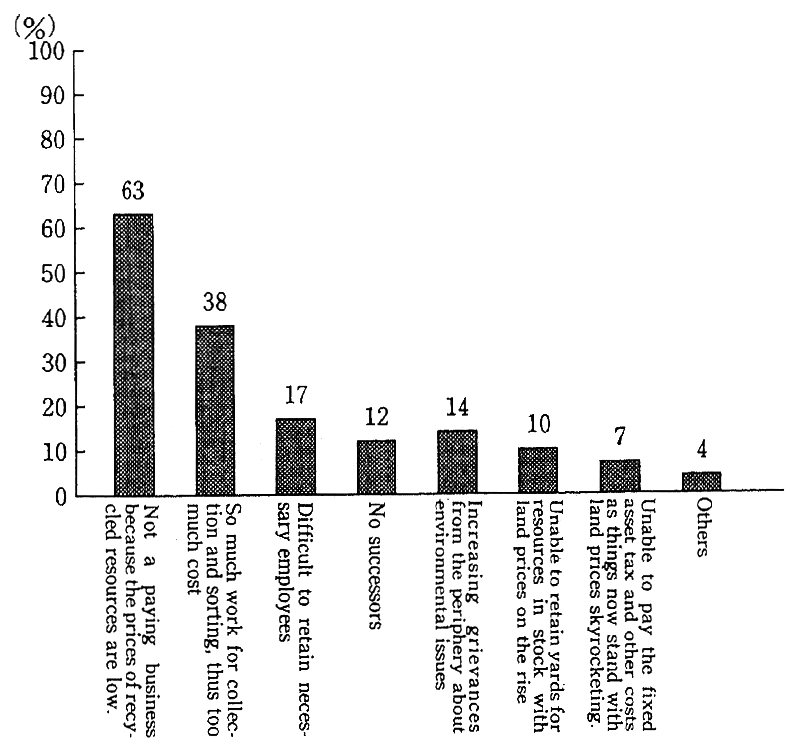
Source: Clean Japan Center, Survey on Trends in Demand and Supply of Recyclable Resources
Where recycling stands now varies, depending on each item, but it is common to all of them that the prices of recycled goods remain low, so dealers in recycled resources find themselves in bad shape. The findings of a questionnaire on dealers in recycling resources suggest that "Our business cannot be put on a paying basis as the prices of recycled goods are too low" and "Our business is too costly because of too much recovery and sorting work," among others. (Fig. 4-1-9). As measures to promote recycling, "Local governments shall take price compensation and other measures for price stabilization," "Households in general and business establishments shall adopt a cost-sharing practice to compen- sate for the recovery cost" and "A framework shall be worked out where recovery agents will involve themselves in the recovery of trash done by local governments so that the trash thus collected may be sorted and recycled," among others, were enumerated (Fig. 4-1-10). Those replies suggest the notion of recycling agents that it is necessary to share the recycling cost with local governments and residents as it can no longer be sustained only by dealers in recycling resources. In order to uncork bottlenecks, it has become necessary for a wide variety of related persons to share the role of promoting recycling and cooper- ate with one another, instead of leaving the whole matter to the corpo- rate efforts of dealers.
Fig. 4-1-10 Views on Measures tofor Promotion of Recycling by Recyclable Resourdce Collectors
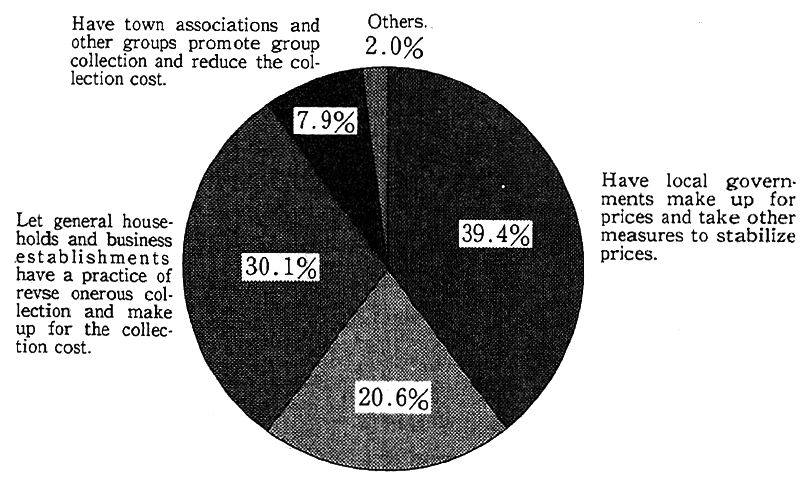
Here, we will take up as an example the recycling of paper in an attempt to shed lighton the present state of recycling.
(2) Present State and Issues of Paper Recycling
a. Environment Loads from Paper Production and Consumption and Significance of Recycling
Paper output and consumption in Japan had sharply increased in the several years preceding 1991. In conjunction, the consumption of lumber as a resource has gone up, and the volume of discarded paper has also risen. In 1992, however, consumption was lower than in the preced- ing year, for the first time in 11 years, due to a recession, and the consumption of umber as a resource was also down (Fig. 4-1-11).
Fig. 4-1-11 Trend in Pulp Consumption
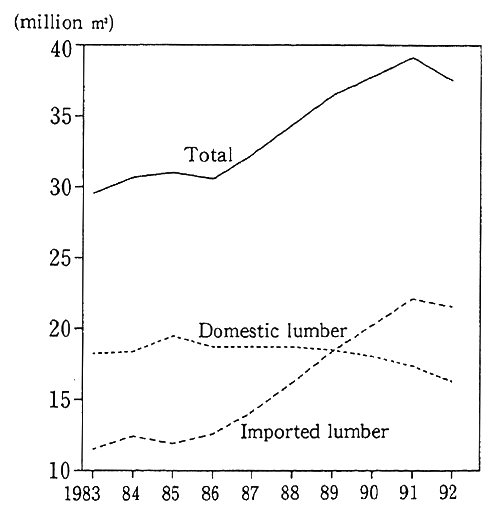
Source:Paper and Pulp Statistics
The share of imported lumber used for paper production (known as the pulp material) stood at 57% (in 1992), and most of the exporters were developed countries. Low-quality lumber unsuitable for lumbering and residual lumber are primarily used. When it is taken into account that about 40% of Japan's lumber consumption is set aside for paper production, it is desirable to shift to forests managed sustainably instead of recklessly increasing the consumption. This approach is also important for the sound development of regions which are dependent on forest resources.
Wastepaper turns out to be a major causative factor for increases trash as a whole. In Tokyo's special wards, for example, wastepaper accounted for about 80% of the increase registered in four years before fiscal 1990. The increase of wastepaper, along with plastics, is respon- sible for a rise in the caloric value of trash and a drop in the working rate of incinerators. Thus, wastepaper has become a factor for a rise in the volume of trash collected and then disposed of. Given this picture, it is an urgent task to reduce wastes, including wastepaper.
When it comes to paper, therefore, there are calls for efforts to reduce the use of virgin pulpwood. For this, it has become necessary to cut back unnecessary paper consumption and promote the recycling of discarded paper.
The effects of paper recycling lie not just in reducing the volume of wastepaper and the use of lumber as a resource. It is also reduces energy consumption. According to a trial computation of the Environ- ment Agency, energy consumption in the pulp production phase with wastepaper is about one-fourth that which is made in the production of pulp with virgin resources. In plain language, the energy-saving effect here amounts to about 2,549,000 kcal (about 280 liters in terms of crude oil) per ton of pulp. On the other hand, wastepaper consumes more energy in the transport phase but is quantitatively insignificant when compared with the energy-saving effect in the production phase. Such a cutback in the use of energy paves the way for reducing loads on the atmospheric environment, such as by carbon dioxide and nitrogen oxides.
Table 4-1-4 Production Cost of Old Paper and Generation Volume of Water Pollution Loads
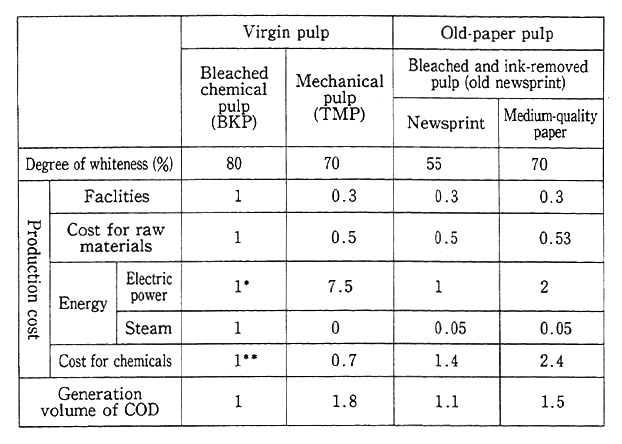
Notes: The facilities and the generation volumes of energy and COD are expressed with BKP at 1.
* For chemical pulp, in-house power generation is done with the condensation and combustion of lignin which melts and gushes out in the steaming and dissolving of tips.
* * "Chemical pulp" includes chemicals for steaming and dissolving in addition to bleaching chemicals.
Source: Japan Development Bank, Survey No. 166
On the other hand, it is possible for paper recycling to affect water quality. Table 4-1-4 is a comparison of the production cost and the volume of generated COD for mechanical pulp produced from wood tips, bleached chemical pulp, and bleached and printing ink-removed pulp made of discarded newsprint. A check of the COD generation indicates that it is smaller for pulp with wastepaper as a resource than f or chemical pulp but larger than for bleached chemical pulp. Above all, the higher the degree of whiteness, the greater the generation. Because the centerpiece of virgin pulp is bleached chemical pulp, it is possible for the COD generation to go up with a growing use of wastepaper. Given this factor, it is necessary to pay full heed to drainage in the promotion of paper recycling and, when it comes to the quality of paper, to use as much as possible paper in which the degree of whiteness is low. The higher the degree of whiteness, the higher the expenditures for electric power and chemicals as well. Having said that, the recycling of paper is effective in reducing environmental loads, so there is the need to promote it to a further extent. Here, let us take a general view of developments in Japan's efforts for the recycling of paper and think about tasks for a further promotion of recycling.
b. Conditions of Paper Recycling in Japan
First, let us compare paper recycling in Japan with that of other countries (Fig. 4-1-12). When it comes to paper recycling, Japan is among the world's most advanced countries. In the discarded paper recovery rate, Japan comes next to the Netherlands. A check of trends in the past reveals that paper recycling in Japan has for long been at a high level. On the the hand, paper recycling in a number of countries, including Germany and the United States, began to show signs of an upturn from a perspective of environmental conservation--the question of urban throwaways, in particular--in the latter half of the 1980s, and some of them have come closer to Japan.
Fig. 4-1-12 Trends in Rate of Old-Paper Collection by Country
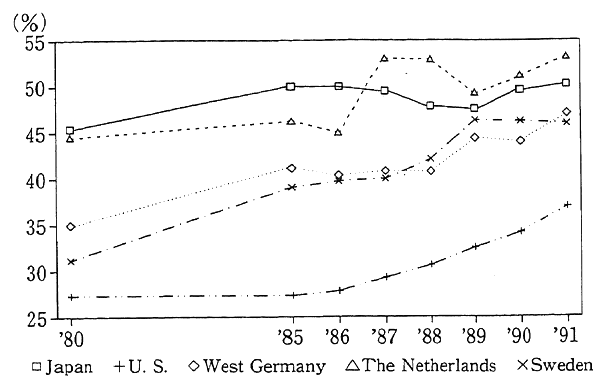
Source : Pulp and Paper International
Next, let us take a look at the steps Japan has taken to date. As you will see in Fig. 4-1-13, the rates for the utilization and recovery of wastepaper have been on the upswing since the oil crunch in or around 1975. This is because the paper and pulp industry used wastepaper, which was a domestically generated resource and which had economic merit in being a stable supply at moderate prices.
Fig. 4-1-13 Trends in Old-Paper Collection and Utilization Rates
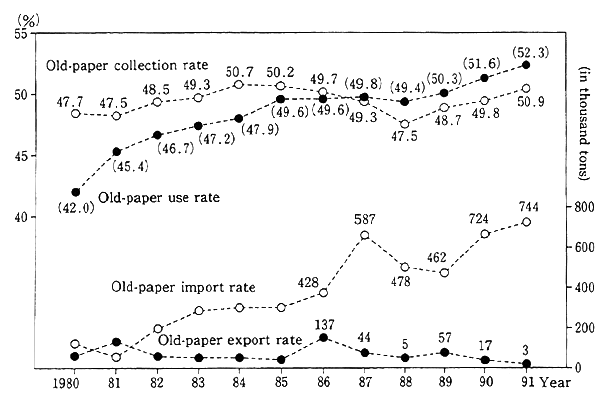
Source: Old-Paper Recycling Promotion Center, Statistical Yearbook on Old Paper
In and after 1985, the rise in the wastepaper utilization rate came to a standstill, as demand for office automation (OA) paper, the waste- paper mixing rate of which was lower than before, was on the rise and the prices of imported tips remained lower and more stable due to the rising yen and other factors. Because paper imports were on the rise, the domestic sale prices of wastepaper stayed at low levels as was the recovery rate of widely used OA paper, in fact lower than the recovery rate in 1987.
In or around 1988, however, the meaning of recycling was recon- sidered from a perspective of environmental conservation, and the recovery and use of sorted wastepaper became widespread in many sectors. In 1990, the Japan Federation of Paper Manufacturers came out with Recycling 55 Plan with a view to raising the wastepaper utilization rate to 55% in the subsequent five years. In 1991, a law was enacted to promote the use of recycled resources. In this law, the "specified lines of business" in which the paper manufacturing industry should step up the utilization of recycled resources were designated, and it was made a public target to raise the wastepaper utilization rate to 55% by fiscal 1994. Given those efforts in line with this law, the wastepaper utilization rate came to 52.3% and the wastepaper recovery rate to 50.9% with the recovery rate reaching to the one-time peak registered in 1984.
Thus, paper recycling has been in progress in the efforts made in recent years, but a check of the present situation shows many problems. The biggest problem these days is that demand for wastepaper has come to a standstill. While the rise in paper production is dull due to an ongoing business slowdown. There is progress in the recovery of wastepaper, but demand among paper manufacturers for wastepaper is held in check, lowering prices. For this reason, the corporate manage- ment of wastepaper recovery is decreasing as inventories rise (Fig. 4-1-14).
Fig. 4-1-14 Trends in Prices and Inventories of Old Paper
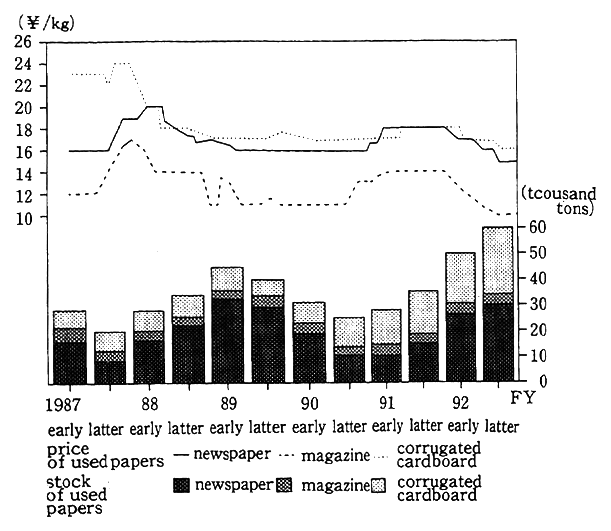
Notes:
1. The prices of old paper are those on delivery to makers' plants in Tokyo's suburban areas.
2. The volume of old paper in stock is that of 32 direct-delivery wholesalers in the Kanto region. However, the data for each month are averaged for the year's first and second halves.
Source: Prepared on the basis of data from the Old-Paper Recycling Promotion Center
Recovery efforts are being stepped up, but the recovery of used paper by offices, for which a recovery system has not been established, is not in full effect. On the other hand, there is a danger that the existing recovery routes might become fragile with a deterioration of waste- paper recovery agents' corporate performance. For the further promo- tion of paper recycling, it is necessary to solve problems of both utility and recovery.
c. Problems for Promotion of Paper Recycling
In order to take account of the aforementioned problems both in the recovery and utilization sectors and work for their solutions, let us see what problems are posed for wastepaper recovery agents, paper manufacturers and consumers.
(a) Problems As Seen by Recovery Agents
Wastepaper recovery agents play an important role in collecting, stocking and sorting wastepaper and delivering it to paper manufac- turers. Recycling in Japan has been sustained in large measure by recovery agents, and, it is essential to see to it that the management of the recovery business is sound. When it comes to wastepaper, however, demand and supply are out of balance; its prices hover low and there are signs of a rise in what agents have in stock. But if local governments and residents promote the recovery of wastepaper, recovery agents will have no choice but to cooperate with them and take it in, so that the business environment of agents is deteriorating. Viewed from the posi- tion of recovery agents, it has become an urgent task to do something about their business environment, given a rise in the supply of waste- paper. There are calls for an increase in the use of wastepaper by paper manufacturers, consumers of products with a high wastepaper blending rate and the increase use particularly by consumers who use paper in bulk such as public entities.
In the recovery of wastepaper, on the other hand, thoroughgoing sorting is desirable on the part of consumers, as the burden of sorting work on the part of recovery agents is on the rise with a diversification of the types of wastepaper, including compound materials.
(b) Problems As Seen by Paper Manufacturers
Japan is among major paper producers the highest level of wastepaper recovery rates. As the use of discarded paper is promoted by paper manufacturers, there are signs of a rise in the use as is the case with other major paper producing countries. Nonetheless, the demand and supply of wastepaper is out of balance, as the domestic utilization of wastepaper does not equal its recovery rate. Paper manufacturers are unable to cover costs for products for which there is no demand. In order to promote the further utilization of wastepaper, therefore, it is necessary to boost demand by consumers for recycled paper and prod- ucts with high wastepaper blending rates.
As for the purchase of wastepaper, its utilization must have merits as a resource in terms of quality and cost, and wastepaper lower in price and higher in quality is needed.
(c) Problems As Seen by Consumers
There are indications that when it comes to the utilization of discarded paper, consumers look for products with less wastepaper blending rates for quality and appearance is sake. The prime unit for the consumption of wastepaper is the rate of wastepaper consumption to output, and a check of this rate for each type of paper indicates that the prime units for hygienic paper (tissue paper, towel paper and toilet paper, among others) have sharply dropped in recent years, though they were high earlier (Fig. 4-1-15). This is because the shares of various hygienic paper products, such as toilet paper made of virgin paper are on the upswing. When it comes consumers, there are signs that they opt for readily usable products and those good in appearance without the environment taken into account in situations where there is a lack of information about environmentally desirable products and chances to buy them. In order to facilitate them to select products with less environmental loads, therefore, it is desirable for paper producers to strive for improvements in the quality of products and for drops in their prices. Producers and distributors are also asked to replenish the stock- ing of such products and offer information and, conversely, see to it that products with heavy loads on the environment may not be excessively advertised and sold.
Fig. 4-1-15 Trends in Prime Unit for Consumption of Kld Paper and Cardboard by Main Type
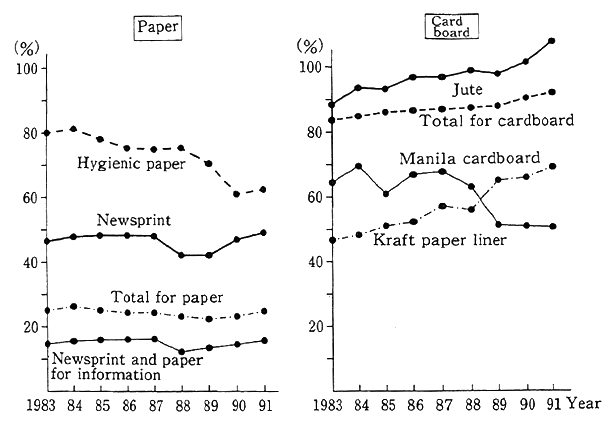
Source: Prepared on the basis of data from the Old-paper Recycling Promotion Center
(d) Problems As Seen by Office and Other Proprietors
Recycled paper has yet to be fully used by office and other proprietors. The use of recycled paper, such as for office automation, became widespread in or around 1989, but the prices of recycled paper remain somewhat higher and it is still thought that recycled paper with low degrees of whiteness is low in quality. These two factors are impeding a further use of recycled paper. For this reason, the prime units of paper for printing and information, which accounts for about 57% of paper output, remain low though they have steadily risen Thus, entrepreneurs are increasingly hoping for the supply of recycled paper higher in quality and lower in price.
When it comes to recovery, the number of agents engaged in the recovery of sorted wastepaper has been on the increase, but recovery from offices is lagging behind that of other sectors. The reason is because a recovery system in which agents may readily join has yet to be established, because it is difficult for offices in the center of a city to secure places for the warehousing of wastepaper, and because the handing of classified documents is difficult. Given those factors, entre- preneurs want to develop a recovery system responsive to those circum- stances.
d. Direction of Future Approaches
We have seen the present state and problems of recycling with paper as an example. As we have said at the outset, the problems that are common to various products have emerged. Viewed from the position of each entity associated with recycling, we realize that there are many issues which cannot be individually solved and for which approaches by other entities are also required. Recycling is is necessary and beneficial for society as a whole, but as long as each entity pursues its own profits, those questions cannot be solved, nor can recycling be stepped up. In order to further step up recycling for the benefit of society as a whole, there is the need for the appropriate sharing of roles so that the promotion of each entity's voluntary approaches may enable them to cooperate with one another.
For realization of the appropriate sharing of roles by each entity, there are sectors which require a framework for the official promotion of burden sharing, instead of relying entirely on voluntary approaches, From this point of view, the State enacted a law for promotion of the utilization of recycled paper in 1991 and, in accordance with this law, took measures, depending on the types of commodities which were to be recycled, such as by setting targets for the wastepaper utilization rates to promote the increased use of discarded paper by paper manufac- turers. As systems to encourage consumers to use merchandise of the kind which is beneficial to the environment, including recycled paper, returnable bottles and other items usable for recycling, the Japan Environmental Association is supporting the Eco Mark project and the Discarded Paper Recycling Promotion Center is supporting the Green Mark project. As a deposit system is in force in foreign countries and some parts of Japan for some commodities, various other frameworks are possible, and there are calls for the promotion of recycling with the cooperation of related persons through appropriate institutional frame- works and voluntary approaches. In the Bill for the Basic Environmen- tal Law submitted to the 126th Diet Session in March 1993, it is stipulat- ed that entrepreneurs shall strive for the utilization of recycled resources and so forth, and that the State shall take measures necessary for the promotion of recycled resources and implement necessary measures which will pave the way for the promotion of voluntary activities by entrepreneurs, the people or private organizations, among others, to collect recyclable resources.